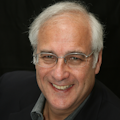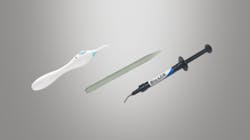I have it—you want it! Bio-LCB, AutoFlosser, Soft Tissue Trimmer
Bio-LCB
A common question is, “Must I use a base/liner under my restorative material?” The simple answer is, “Why would you choose not to do so?” Essential Dental Systems’ Bio-LCB (light-cured base and liner) is a great answer to that question and a very good example of what benefits a base/liner can provide.
More "I have it—you want it!":
First and foremost, it helps to prevent secondary decay by stimulating reparative dentin growth via its release of calcium and phosphate ions. This light-cured material (10” with LEDs over 1000 mW/cm2) will bond to dentin, thus preventing bacterial leakage and sensitivity by sealing off the dentinal tubules. Furthermore, Bio-LCB becomes alkaline upon setting, which has an antimicrobial effect and helps maintain healthy, noninfected pulpal tissue. A proprietary UDMA-based (urethane dimethacrylate-based) formulation increases pH levels while forming calcium hydroxide to stimulate secondary dentin growth. The associated calcium phosphates have a further positive effect of aiding the remineralization of the affected dentin. This low-polymerization-shrinkage, flowable material is not runny, is highly radiopaque, and comes in a syringe for easy, direct application. You can use Bio-LCB under alloy, composite restoratives, or cements, and it is an ideal substitute for IRM/ZOE (polymer-reinforced zinc oxide-eugenol), GICs (glass ionomer cements), or RMGIs (resin-modified glass ionomers). Essential Dental Systems is perhaps best known for the array of materials and products that are endodontically oriented (e.g., Flexi-Post), yet they have developed a terrific material that will perhaps prevent the need for endodontic therapy. Bravo, EDS!
AutoFlosser
This unique device has a great slogan that sums up the product: “Point. Floss. Smile!” Developed by periodontist Dr. Thomas Jackson, the AutoFlosser is ideal for cleaning in and around difficult areas that involve braces, bonded retainers, stationary bridges, and implants (think all-on-four, etc.).
As the slogan says, you simply load the device with the floss thread, turn the thumb wheel, and direct the floss (with its rubber tip). Use the wheel to guide the specifically designed floss into the area to be cleansed, then use your other hand to grab the floss tip and clean the area as you would with a conventional flossing technique. It is that simple. As you move to the next area, simply pull the floss back through the AutoFlosser and then direct it into the next area, again using the wheel to push the stiffer end of the floss through for cleansing. It has been proven that flossing is a critical component of maintaining oral hygiene. The necessary dexterity to floss can sometimes be a hinderance for pediatric and geriatric patients. The kit, which is relatively inexpensive, includes 30 pieces of floss, and refills are available. AutoFlosser facilitates flossing for patients of all ages and is thereby a useful device for maintaining optimal dental health and a beautiful smile.
Soft Tissue Trimmer
Not every dentist has a soft tissue laser or wants to use a scalpel to remove tissue that may be in the way of the procedure they are performing. But everyone does have a high-speed handpiece. The Soft Tissue Trimmer from Dentalree is a bur designed to run at very high speeds (300,000–450,000 rpm) without water to remove soft tissue in a variety of instances.
While I generally do use my soft tissue laser, I did find it useful for removing tissue to access subgingival decay, recontouring tissue, and the removal of granulation tissue. Other uses include crown lengthening, uncovering implants, widening the sulcus prior to taking an impression, operculectomy, and exposing partially erupted third molars. An important technique tip is that you should always run the tip for about 30–45 seconds to create heat generation at the tip and then use it without any water spray. Dentalree also offers a practical solution for removing zirconia restorations, which are difficult to do with conventional diamonds or carbides, called Cyclone burs. These are highly efficient and require only light pressure with plenty of water. There are several shapes available, and I would suggest starting with the ZRR Kit, which has the most popular tips.
Editor's note: This article appeared in the April 2023 print edition of Dental Economics magazine. Dentists in North America are eligible for a complimentary print subscription. Sign up here.
About the Author

Howard S. Glazer, DDS, FAGD
Howard S. Glazer, DDS, FAGD, is a fellow of the Academy of General Dentistry, American College of Dentists, International College of Dentists, American Society for Dental Aesthetics, American Academy of Forensic Sciences, and a diplomate of the American Board of Aesthetic Dentistry. He is an attending dentist at the Englewood Hospital in Englewood, New Jersey, and the deputy chief forensic dental consultant to the Office of Chief Medical Examiner, City of New York.
